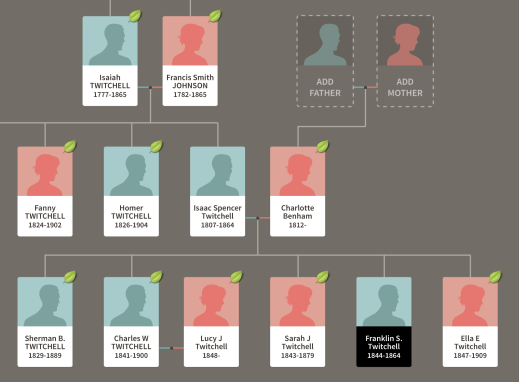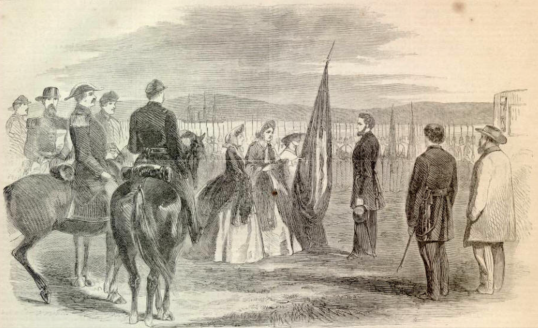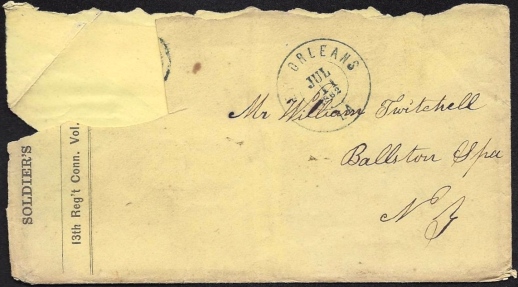This collection of Civil War letters by Franklin S. Twitchell was purchased by an acquaintance of mine who asked me to transcribe them and preserve them on this blog for the benefit of historians and family history researchers.
FAMILY
Franklin Twitchell (1844-1864) was the son of Isaac Spencer Twitchell and Charlotte Benham. According to a family history, Isaac was born in Oxford, Connecticut about 1807. “He was a watch and clock maker; also a manufacturer of jewelry. Shortly after attaining his majority, he removed to Ballston Spa, New York, where he engaged in the lumbering business in the Adirondacks. Having disposed of his timber and lumbering interest, he removed with his family to New Haven, Connecticut, where he engaged in the manufacture of silverware, in partnership with a person whose name is not now recalled. During Mr. Twitchell’s absence from New Haven, his partner made substitution of some base metal for the percentage of silver stamped upon the manufactured product and before Mr. Twitchell’s return left the country. These deceptions were discovered by purchasers of the silverware and Mr. Twitchell was left penniless in his efforts to make restitution and to secure a return of his good name. He returned to his trade of watch and clock repairing. With his son, Sherman, he finally left Connecticut, and settled in the state of Minnesota where he died.” [Source: Genealogy of the Twitchell Family]
To the best of my knowledge, the children of Isaac and Charlotte (Benham) Twitchell were:
- Sherman B. Twitchell (1829-1889)
- Charles William (“Bill”) Twitchell (1841-1900)
- Sarah J. Twitchell (1843-1879)
- Franklin S. Twitchell (1844-1864)
- Ella E. Twitchell (1847-1909)
SERVICE
Franklin S. Twitchell enlisted as a corporal in Co. B, 13th Connecticut Infantry. They were mustered into the service between November 25, 1861 and 7 January 1862.
“Following the Union disaster at Bull Run in July 1861 additional regiments were raised throughout the north to continue the struggle. Among these was Connecticut’s Thirteenth Volunteer Infantry Regiment. Though organized in New Haven, the unit boasted recruits from many parts of the state when it sailed for the Gulf Coast in March 1862.
Pressed into occupation duty in New Orleans, the men of the unit quickly found themselves in the middle of a war of words between pro-Southern and pro-Union factions in the city. During these first months in Louisiana a considerable number of recruits took ill and were discharged. New recruits, many of them German immigrants living in New Orleans, replenished the unit’s strength.
Ultimately the Thirteenth operated primarily in the Lower Mississippi Valley, its most notable actions the bloody Union assaults and subsequent siege of Port Hudson, Louisiana, from May to July 1863. The regiment then participated in the Union’s abortive Red River campaign in early 1864.
Following a brief veteran’s furlough back home in the summer of 1864 the regiment was ordered to join General Sheridan’s forces in the Shenandoah Valley of Virginia. The Thirteenth last saw heavy action at Opequan and Winchester, Virginia, in September. The three-year enlistment period for most of the men ended in December, the remaining troops being sent to Savannah, Georgia and, later, Newbern, North Carolina, at the war’s end.
So how lucky was the Thirteenth? When officially mustered out of service in May 1866 the regiment could truly count itself fortunate to have suffered only 197 deaths from all causes, of which 53 were combat related.” [Source: What’s in a Number? Connecticut’s Thirteenth Regiment Goes Off to War, by Richard Malley, Head of Collections at the Connecticut Historical Society]
Franklin re-enlisted as a veteran in February 1864 and was with his regiment in September 1864 when he was taken prisoner at the Battle of Winchester on 19 September. He is reported to have died on 9 December 1864 at the Confederate Prison Camp at Salisbury, North Carolina. By November of 1864, Salisbury Prison “held more than 10,000 men. The death rate became appalling: 28% of soldiers held there died in captivity. Burials before the overcrowding had been in coffins and in separate graves. Records exist that indicate military burial services were even given. However, due to the large number of men dying daily, after October 1864 a mass burial system was initiated. The bodies were collected daily and taken to the “dead house” to be counted and loaded onto a one-horse wagon. At 2:00 PM each day this wagon of the dead would be taken about ¼ mile to an abandoned cornfield where the men were buried. Eighteen trenches of approximately 240 feet each were eventually needed. These trenches are visible today.”
THE LETTERS
There are thirteen letters in this virtual archive that were written between 30 October 1860 and 8 August 1863. The letters written on 3 December 1862 and 19 April 1863 are housed at the Louisiana State Library, in Baton Rouge. The others are privately owned. There are likely more letters elsewhere but I have not yet found them.



